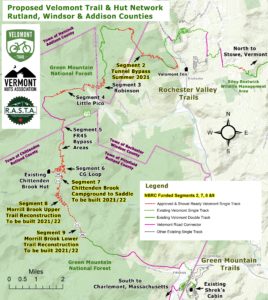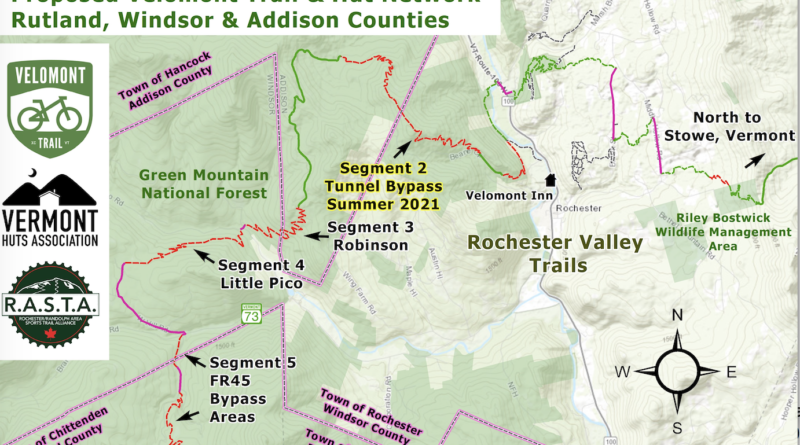Vermont Hut and Trail System Wins $526K Grant
Thanks to a grant of more than half a million dollars, Vermont is one giant step closer to having. backcountry hut-to-hut trail system, one that would let you hike, bike or ski —eventually— from the Canadian to Massachusetts border while staying at backcountry huts along the way. Work has already begun on the proposed Velomont Trail. [See A Vision for Velomont] . The grant will allow for a key section from Killington to Rochester to be developed in the next year.
The Velomont Trail Collective and Vermont Huts Association announced in the following release that they are the beneficiaries of a Northern Border Regional Commission grant to continue work on the Velomont Trail and Vermont Huts network, bringing the concept of an end-to-end, hut-to-hut mountain biking trail in Vermont closer to reality.
“The grant totals $526,375.48 and will fund construction of key sections (10 mi) of the Velomont Trail in the towns of Chittenden, Rochester and Hancock, as well as contribute towards the funding of a proposed year-round ADA accessible backcountry hut in Chittenden.
These sections are “shovel-ready” for construction of the single-track trail and will connect popular mountain bike trail networks in Rochester and Pittsfield. The Velomont Trail Collective has partnered with the Vermont Huts Association and 21 trail organizations with the intent of doing for mountain biking what the Long Trail and Catamount Trail have done for hiking and cross-country skiing. When finished, the Velomont Trail and VT Hut network will connect 12 counties and 23 communities from Canada to Massachusetts. Huts will be strategically located along the trail for overnight use, making it ideal for multi-day adventures for beginners and experts alike.
“We are thrilled that the Northern Border Regional Commission approved our grant application,” said Angus McCusker, the Velomont Trail Collective Executive Director. “The Green Mountains have some of the best mountain bike trail networks in the world, and we have been dreaming of a trail connecting these networks for quite some time.
 This is the first section that will showcase how we want to connect Vermont’s towns, villages, and trail systems end-to-end for mountain bikers in Vermont.” Vermont Huts Executive Director RJ Thompson says the future is bright for recreation in Vermont. “COVID-19 put a lot of stress on Vermont’s trail systems due to the rapid increase in demand, but it also highlighted how much we value our forests and the tremendous opportunities they provide for everyone. It’s exciting to see state and federal governments recognizing this demand by providing the financial resources to keep up with growth in trail and hut usage,” said Thompson.
This is the first section that will showcase how we want to connect Vermont’s towns, villages, and trail systems end-to-end for mountain bikers in Vermont.” Vermont Huts Executive Director RJ Thompson says the future is bright for recreation in Vermont. “COVID-19 put a lot of stress on Vermont’s trail systems due to the rapid increase in demand, but it also highlighted how much we value our forests and the tremendous opportunities they provide for everyone. It’s exciting to see state and federal governments recognizing this demand by providing the financial resources to keep up with growth in trail and hut usage,” said Thompson.
Green Mountain National Forest Recreation Program Manager Holly Knox echoed that sentiment. “This project has been developed by many voices who agree it will contribute to the social, economic, and physical wellbeing of our local communities and visiting publics. In addition to the compelling conversation regarding these benefits, the Forest Service is proud to be part of a state-wide initiative that connects more people, especially future generations, to their public lands and the critical need to be active stewards of our shared resources,” said Knox.
The grant award is the result of multiple organizations working together to reach a common goal. “The Trust for Public Land is thrilled to participate in this effort to expand recreation opportunities and improve access to the outdoors,” noted Kate Wanner, Senior Project Manager for The Trust for Public Land. “Our efforts to permanently conserve Rolston Rest, the largest private inholding in GMNF, will be leveraged by the new proposed hut and trail infrastructure improvements on Rolston Rest and National Forest land to the north towards Pittsfield. Throughout Vermont, we’ve seen how public trail networks contribute to healthy and vibrant communities and improve quality of life for all who use them.”
The trail and hut network could bring needed revenue to rural communities that have yet to reap the full benefit of tourism in our state. A recent economic analysis estimated what the entire trail and hut network could do for the state once complete. It found 16,000 – 36,000 annual visitors would use the Velomont Trail and its supporting huts. These users could generate an estimated $3.5 – $6.2 million in annual sales activity, resulting in $385,000 – $685,000 in VT tax revenue while supporting 51-91 full time jobs.
“We aim to build not just a trail and hut network, but an opportunity to enjoy all Vermont has to offer, including locally sourced meals and brews,” added McCusker. “Since the Velomont Trail will pass through our rural towns and villages, riders can enjoy a latemorning breakfast at a local shop or snag a mid-afternoon snack before heading to their next backcountry destination,” said Thompson. The grant is being administered through the Two Rivers-Ottauquechee Regional Commission (TRORC). The Town of Killington, The Trust for Public Land, Vermont Huts Association, and Rochester/Randolph Area Sports Trail Alliance (R.A.S.T.A.) have pledged a combined $283,500 to match the NBRC grant.
“TRORC has been a proud partner in assisting the Vermont Huts Association in planning, and now implementation, of projects that have such amazing benefits including, being outdoors, improving public health and enhancing our region’s economic opportunities,” said Peter Gregory, TRORC Executive Director. The NBRC grant and matching monies will help to fund a section of the central sector of the Velomont Trail, connecting Stowe to Killington. This section will eventually total 162 miles of existing and new trail, connecting nine towns with 12 new backcountry huts at a total cost of approximately $4.8 million.
The entire Velomont Trail, from the Canadian to the Massachusetts border, including 30-45 Vermont Huts, is estimated to cost $15 million. To learn more about the Velomont Trail, visit www.velomonttrail.org. To learn more about the Vermont Huts Association, visit www.vermonthuts.org. ##
About the Velomont Trail Collective (www.velomonttrail.org) The Velomont Trail Collective is comprised of 21 stakeholders—mostly trail organizations in all parts of Vermont—plus the Vermont Huts Association, working to bring the Velomont Trail to fruition. Stakeholders include: Deerfield Valley Trails/Thunder Mountain Bike Park, Catamount Trail Association, Jamaica Area Mountain Bike Association, Hoot Toot & Whistle, Southern Vermont Trails Association, Northshire Area Trails System, Merk Forest & Farmland Center, Slate Valley Trails, Pine Hill Partnership, Killington Mountain Bike Club, Rochester/Randolph Are Sports Trail Alliance (RASTA), Mad River Riders, Fellowship of the Wheel, Sleepy Hollow Inn Ski & Bike Center, Richmond Mountain Trails, Cochran’s Ski Area, Bolton Valley, Waterbury Area Trails Alliance, Trapp Family Lodge, and Stowe Trails Partnership. About the Vermont Huts Association (www.vermonthuts.org) Founded in 2016, the Vermont Huts Association aims to provide an enriching and immersive outdoor experience for everyone.
By collaborating with their partners in recreation, they are creating a four-season hut network across the Green Mountain State to strengthen local communities and foster a deeper appreciation of our natural environment. The nonprofit organization is comprised of eight hut locations – and growing – located on federal, state, and private lands across Vermont. All huts are located on or in close proximity to skiing, hiking, or mountain biking trails, and guests are able to reserve huts online in advance of their stay.
About the Northern Border Regional Commission (www.nbrc.gov) Created in 2008, the Northern Border Regional Commission is a federal-state partnership whose mission is to help alleviate economic distress and encourage private sector job creation in Maine, New Hampshire, New York, and Vermont. In its twelve-year history, the Commission has awarded 287 grants amounting to more than $72 Million across the four states through its primary Economic & Infrastructure Development (EID) grant program and other special initiatives. About The Trust for Public Land (www.tpl.org) The Trust for Public Land creates parks and protects land for people, ensuring healthy, livable communities for generations to come


